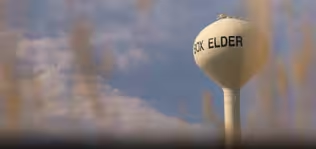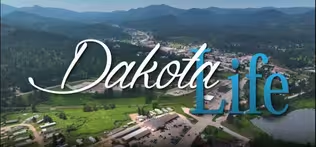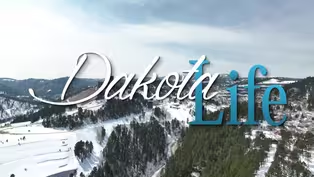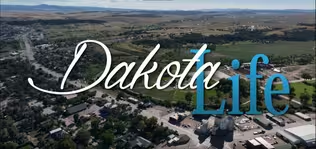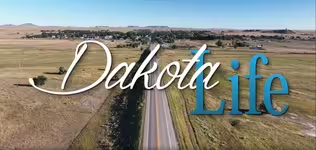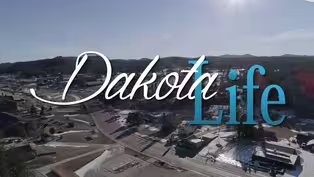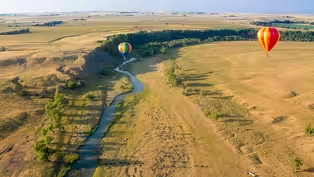Dakota Life
Greetings from Union Center
Season 26 Episode 3 | 27m 53sVideo has Closed Captions
Greetings from the ranching community of Union Center.
Meet a woman who’s become a ranching advocate and a young man who’s mastered two traits essential to ranch life, and learn about a one-of-a-kind ranch family tradition bringing this rural village closer together.
Problems playing video? | Closed Captioning Feedback
Problems playing video? | Closed Captioning Feedback
Dakota Life is a local public television program presented by SDPB
Support Dakota Life with a gift to the Friends of Public Broadcasting
Dakota Life
Greetings from Union Center
Season 26 Episode 3 | 27m 53sVideo has Closed Captions
Meet a woman who’s become a ranching advocate and a young man who’s mastered two traits essential to ranch life, and learn about a one-of-a-kind ranch family tradition bringing this rural village closer together.
Problems playing video? | Closed Captioning Feedback
How to Watch Dakota Life
Dakota Life is available to stream on pbs.org and the free PBS App, available on iPhone, Apple TV, Android TV, Android smartphones, Amazon Fire TV, Amazon Fire Tablet, Roku, Samsung Smart TV, and Vizio.
Providing Support for PBS.org
Learn Moreabout PBS online sponsorshipMore from This Collection
Dakota Life stories from towns in western South Dakota
Video has Closed Captions
The community of Box Elder is one of the fastest-growing cities in South Dakota. (28m 52s)
Video has Closed Captions
Visit an artist coop, the state railroad museum, gardening enthusiasts, and an annual film (25m 49s)
Video has Closed Captions
Dakota Life visits Custer and the surrounding area. (24m 56s)
Dakota Life: Postcard from Hot Springs
Video has Closed Captions
Dakota Life: Postcard from Hot Springs (29m 49s)
Providing Support for PBS.org
Learn Moreabout PBS online sponsorship(gentle upbeat music) - [Presenter] This is a production of South Dakota Public Broadcasting.
(country guitar music) - [Larry] In the 1860s, the landscape of South Dakota began to change.
Until that time, it was the domain of Native tribes.
But the Homestead Act of 1862 offered free land, and immigrants began to pour into the plains.
For the next 60 years, homesteaders broke the soil of Dakota territory as it transitioned into the newly-formed states of North and South Dakota.
In the middle of Meade County, along what is Highway 34 today, sits a village that's a testament to the people who settled here.
It was formed in 1926, by the Meade County Farmers Union.
It started out as a store with a cream station and a school nearby.
And because the site was in the center of Meade County, they decided to call it Union Center.
As the years went by, the village grew.
A post office was added, a hall for community gatherings, several churches, and a few other small businesses too.
(tires swish) Some of its citizens are more well-known than the community name.
For instance, Union Center is the home of Lieutenant Governor Larry Rhoden.
- Joint session of the House and Senate will come to order.
- [Larry] For area ranch families and for folks who live in the surrounding communities, Union Center may be their hometown too, or at least, it's the place where you can come together, worship, maybe cheer on the local sports team or pick up your mail, buy supplies, or get a haircut.
But while essential services may not be just around the corner, most of the folks who live here wouldn't trade this place for anywhere else in the world, because this setting is rich with the wonders of the natural world.
The unique character that comes with small town life, and the breathtaking scents you only find in the wide open spaces.
So welcome to "Dakota Life," and "Greetings from Union Center."
(bright upbeat music) - [Announcer] Support for "Dakota Life, Greetings from Union Center," is provided by Farm Credit Services of America, a mission-driven, customer-owned financial cooperative dedicated to serving rural America.
Farm Credit Services of America, agriculture works here.
- Meade County stretches from just north of Rapid City, to Sturgis, east of the Cheyenne River, and all the way northeast to include Faith.
Now, that's almost 3,500 square miles in all.
It's the state's largest county, and it can be many miles from one ranch to the next so neighbors out here rely on each other.
In good times or bad, they band together.
Sometimes, they just like to get together.
That's how the Union Center Hall came to be.
Curtis and Jessie Schwab, the owners of the original Union Center store, built the Union Center Hall in 1936.
They held community dances every couple of weeks.
And now, that was a business venture so it was a dollar admission charge, which was quite a tidy sum in the 1930s.
Local bands provided all the music, and the hall also had a beer license and pool tables in the basement.
Well, because of problems with alcohol and fighting, the owners quit having dances at the hall, and the Union Center Hall went through a series of owners.
And by 1992, the hall had deteriorated to the point that it was no longer safe.
So the people got together and had a barn raising.
The new Central Meade County Community Center was built and still serves the area today.
Coming up, meet a woman who's become an advocate for the ranch community, share some educational history from this area and explore a unique ranch family tradition.
But first, job prospects are a little different out here in ranch country.
Instead of leaving for the city, one young man took it upon himself to learn two trades that are essential to ranch life.
(country music) - Farrier was the old term, and then for a while, horseshoer became the preferred one.
And then kind of funny, nowadays it's kind of reversing again.
- [Larry] For Bobby Timmons, it started when a farrier was working on one of his new horses.
- It was rather funny, he was a really good person to talk to and we were asking him questions and he asked, "would you like to give her a try?"
Hey, and was ones, where you were the first ones to say, "sure thing."
And then got underneath, ah, the legs are shuddering, and shivering, it's like, "ah, kinda, okay, gimme a second and I'll get back under," and we were the first people to do that.
Yeah, and it's kind of funny, I was young enough, he was like, "Hey, would you like to come work with me?"
And I said, "sure, but we gotta wait till I get my learner's permit so I can drive over."
Dad noticed there was a ad for a Horseshoeing Clinic over in Dupree, by a guy named Lee Olson.
And then went over and I learned quite a bit and found there was a lot more to it than I thought.
(upbeat guitar music) He recommended a school in Minco, Oklahoma.
It's Five Star Horseshoeing School, run by Dusty Franklin.
I went down there and learned that there was even more hurt to it than I thought then.
(Larry laughs) (bright upbeat music) (file scrapes) (hammer taps) (horse manure plops) (shovel scrapes) (hammer taps) (fire rushes) (bright music continues) I've been lucky, I've met a lot of really good teachers.
At the moment I am a certified farrier of the American Farriers Association.
And then hopefully in the fall, I go for the certified journeyman end exam and pass that one.
- [Larry] What happened next not only says a lot about Bobby, but it says a lot about his neighbors from around Union Center.
(hammer taps) - I think about a year or two after that I was trimming some horses for Richard and Karen Butler.
They run the insurance agency that we go through and then later, Richard had sent me an envelope and said, if you wanted to, I would pay for you to go to this blacksmithing school in Sheridan, Wyoming.
Hey, and then called him up, "Well, sure thing."
Hey, I was very flattered 'cause he paid for me to go to all three, he had three sets of classes and he's got a hotel there that he let me stay in.
- [Larry] So armed with his farrier and new blacksmithing skills, Bobby loads up his mobile workshop and travels the region.
This is indispensable.
- Indeed, yeah.
Oh, and most of my work is in the Rapid City, Belle Fourche, Philip area, I've got some I do in Burke.
And then there's a bunch I'm doing with a partnership with another horseshoer over East River.
- Really?
- Yep.
But mostly through word of mouth, both is, you know, working with different people and then, you know, doing horses and then the owners telling other people and going from there.
- [Larry] What do they like about you?
- Well, I've had multiple people say they really like that I show up on time and the day that I'm supposed to be there.
(Bobby and Larry laugh) Well, you know, I talk with the owner and ask 'em about, you know, what the horse does, how have they been.
I look at the confirmation of the horse, you know, starting, when you look at the whole horse, you look at the shoulders, the knees, the fetlocks.
You look and see if there's any deviation in there.
You look at the feet and you see if there's any migration, you know, if they're toed in, toed out, if the feet are flaring to one way or the other.
Keep going and checking off boxes till a person's done.
There, I try pretty hard on that one.
And I try hey, very hard to work with most horses 'cause most of the time if, and either they're just annoyed or if they're in pain and you just gotta work with them.
(gentle music) (hammer taps) While I'm pulling up, squeeze lightly.
(tool clicks) (file rasps) And I found on most horses, you know, long as you don't get mad and fight with them, they're usually better the next time around.
- [Larry] His smithing skills are certainly an asset to his farrier work, but he's thinking beyond that.
(light music) - I've made some meat forks and some other small utensil items and hooks.
Hooks, and just kind of been adding it to the horseshoeing and kind of working on getting it set up so during the wintertime, I can build and set up product.
And then once I get a inventory set up, is go around to different places and see what they'd be interested in selling.
- What is a more iconic image of the American West than that of a cowboy on horseback herding cattle?
But the truth is, women have been a vital part of the cattle industry for generations, but they also bring a very unique perspective to the table.
They find innovative ways to market products and connect with customers, and they use new technologies to improve efficiency.
In short, women ranchers make their mark and contribute to the rich history of ranching in America.
In the early 1980s, Tammy Basel returned home to work on her family's ranch near Fairpoint.
It's about 25 miles northwest of Union Center.
Her dad helped her take over and now, with her husband Dallis, their son and daughter-in-law, they raise sheep and cattle.
(sheep bleat) - [Lura] For more than a century, Tammy Basel's family have raised sheep and cattle on the native prairie she now cares for.
- You know, when people say, you know, it was what you were bred to do, what you were born to do, I 100% believe.
I think I might have been born in the barn, (laughs) but not quite.
But it's just where I find my peace and my satisfaction.
You know, my spot in life.
- [Lura] It seems only fitting that ranching is the only career she ever wanted because it was her grandma, Carrie Wilcox, who homesteaded the land in 1917.
But in the early years, she still had to prove herself.
- And so, you know, it took Dad, my dad and I, a long time to figure it out.
But my dad was very proud of me and he was very supportive.
And you know, if I can remember, there was times when we would put wool in a sack.
Old time sacks were long and round like a cigar, and the new sacks are what fits in shipping containers.
And he would say, "Tammy," to all the males around me, "show 'em how it's done."
Or when it came to pulling a calf, you know, there would be times where I might pick up 100-pound calf that was too big, and just carry it.
And he'd always say, "Tammy, show 'em how it's done."
- [Lura] Her husband Dallis, always knew she was capable.
His family's ranch is next door to Tammy's.
Tammy's son, Ryan LaMont and his family raise sheep and cattle on Dallis' land.
- And it was our first date, he came over for supper.
And we were checking heifers and toes up means the calf is backwards.
And he let me pull the calf.
He didn't need to tell me how to do it, he didn't need to push me outta the way and do it for me.
He let me do it.
And he thought, "well, this is okay, she knows how to cook and pull a calf."
And I thought, "that's okay, he didn't tell me how to do it."
(gentle guitar music) (door bangs) - [Lura] There are numerous reasons sheep and cattle work well together, grazing these western South Dakota rangelands.
- Well, with sheep and cattle, there's actually three cash crops because of our wool, we have quality wools.
Being a dual species grazer has been important to the ranch for many years because when one, when the cattle are high, the sheep might be low.
When the sheep are high, the cattle, but more importantly, the sheep and cattle graze differently.
So you can really raise more pounds of protein per acre by having dual species grazing than just raising just cattle or just sheep.
- [Lura] When she's not caring for livestock, Tammy makes time to advocate for the career and life she loves.
- Well, I want the future to have what I've been given.
I have been having, I've had amazing life and amazing opportunities, but the world is not the same as when I was a kid.
When I mean, the world is very different than when I was 10.
We have social media now, where there's a lot of people that don't want to eat meat, don't wanna wear wool.
- [Lura] Even though meeting with policymakers in DC or consumers during the Sturgis Rally takes her off the ranch, she says it is worth it for a seat at the table.
And she said, advocating today so her children and grandchildren have future opportunities on the family ranch means everything to her.
- You cannot put in words the importance of family.
If it was not for Ryan and Shiloh, very likely, you know, how are you gonna retire?
You know, if there's no family, you would just call the auctioneer.
Now, wouldn't that be sad to think about all the heritage and how many years and generations of sweat equity there is, to just call the auctioneer?
- [Lura] Ryan and Shiloh and their children, Brooke, Logan, and Kole, are grateful for Tammy's efforts and the legacy she and Dallis are leaving to them.
- Ever since statehood, South Dakota has been committed to providing a public education.
(film reel rattles) And for rural areas, that often meant very small schools with maybe only one teacher for all of the grades and all of the students in the community.
And as I mentioned earlier, Meade County is a pretty big place, 3,500 square miles.
So in 1930, there were 160 rural schools to serve the students across the 45 townships that make up Meade County.
Now, forward to post-World War II, efforts began to consolidate and reorganize school districts.
But even today, here in Meade County, there are still five of those small rural schools remaining.
They're in Atall, Elm Springs, Hereford, Opal, and the Central Meade County school, here in Union Center.
Central Meade has four classrooms, but just as important, the school has strong support from the entire community.
- [Tim] Rural schoolhouses brought the people of South Dakota together before they were called South Dakotans.
They were often the first beacon of community to those newly awash in a sea of prairie.
In a time when few things harken back to the homesteading days, (phone rings) today, in Central Meade County, some of those traditions are alive and well.
(gentle music) - Further up on this road.
- They have a tradition there, and we always rode horses the first day of school.
And everybody rode their horse to school.
And the parents (images ring) rode with them most of the time.
And we even had a grandpa that used to ride when his grandkids were still in there, he'd show up on his horse and he'd ride to school with us every year.
And just the community, things like that that you just so look forward to and make it a wonderful time.
- That's one of the best things about teaching out here.
I have great-grandparents who were teachers, a great-grandfather and great-grandmothers who were teachers, on both sides of my family.
They taught in country schools.
These children out here have such a respect and an interest in the history because their grandparents went to school here.
I like to bring that in to the classroom as much as I can.
We've done projects about that because it is so unique for these kids.
- [Tim] Whether teaching or attending, a country school wasn't always a good time.
In addition to bitter blizzards and dodging rattlesnakes, many schools didn't have electricity or running water until the '70s.
At the Rural Neighbors Club, Edna explains her least favorite teaching experience from 1949.
- But the worst thing of all, there was no facilities.
I had to walk over to their house and go down in their basement and use a chemical toilet.
And I'll never forget that.
(group chuckles) - [Tim] But often, it seems uncomfortable situations make the best memories.
- We moved up here and started school, but as we came up the hill, coming to Stoneville, there was some kids riding horses.
I was in the second grade and mother was afraid that the car would scare the horses.
So she got off to the side of the road.
Of course, then we thought we were gonna tip over.
We were only just a skip and a jump from the schoolhouse so the school kids all came down to see what's happening.
One of the school kids that came was Floyd Cammack, the first time I ever saw him.
And we eventually ended up getting married.
He went to school here too, but that was the first time I saw him.
And I never had another boyfriend.
We lived down the road and he lived up the road.
And when we got married I just moved up the road about a mile, and lived there ever since.
- [Tim] While the three Rs of reading, writing, and arithmetic have stayed the same, the rural school system has changed a bit over the years.
- Sometimes there might have been maybe not enough kids there to warrant a school, but it was usually about the funding and not enough money for a teacher for a certain number of kids.
- All five of our kids went here, then our grandkids went here, and then our great-grandkids.
We ran outta kids and so they closed the school.
(bright music) - [Tim] Today there are five rural schools in the Meade County School District, and they share one, well-traveled principal.
Hereford, Atall, Elm Springs, Opal, and newly built in 2019, the Central Meade County school in Union Center.
- It is such a wonderful way to teach.
You don't lose the kids.
- That first year, I think I had seven K-8 students and the room was just so quiet that it really struck me.
- They can't slip through a crack because (laughs) there's nowhere to hide.
They are right there in front of you at the table for every class that you do.
- Being in a small school, while you had more personal attention with your teachers.
- I just can't say enough good about these small rural schools.
They just have a different feel to them, it's just so much better for kids, so many more connections and just that sense of community really comes through.
So huge advocate for small schools.
Yeah, just, it's my dream job.
(laughs) (gentle music) - In 1962, at the height of the Cold War, the landscape around Union Center changed considerably.
The Boeing and aircraft company came to town, establishing a base of operations to build Minuteman nuclear missile sites in the area.
Union Center's population of 20, grew to over 200, but that meant new opportunities.
In all, five missile control centers were built nearby in Mud Butte, Stoneville, Hereford, White Owl, and Opal.
Boeing returned to update the missile silos in the '70s, but as the Cold War cooled off, the sites were decommissioned.
What has remained through the history of the Union Center is that it's a wonderful place to raise a family.
There's a special quality of life for the children who grow up on a ranch.
They grow up sharing responsibilities like feeding and caring for livestock, repairing fences and equipment and other duties as assigned.
Along with other activities, they enjoy school sports, which may include of course, rodeo.
Union Center's Annual Ranch Rodeo is a unique tradition that local families really enjoy.
(country rock music) - [Commentator] Right here, right now we're watching Parker Wilcox, go Parker.
That young man is all business, all business, no doubt about it.
(laughs) There's not a smile, none, nothing, he's concentrating on what he's doing.
- [Lura] Seven-year-old Parker Wilcox is focused as he and his horse, Cornbread, compete in the flag race.
- 'Cause you get to go fast and win the prizes.
- [Lura] Parker, and his twin Hayes, competed in the flag race with about 75 other ranch kids.
(country rock music continues) - Flag so far, is the funnest.
- [Lura] The flag Race is one of several youth events held during the annual Rancher Round-Up.
(country rock music continues) - [Commentator] We got an awful fast run, an awful fast run coming to us in the seven through 10, with a 25, 26, 9 at 25.69 for Ellie.
(country rock music continues) - [Lura] For the Wilcoxes, this Ranch rodeo is a family affair.
The twins' dad, Brett, helps with the flag race and competes in the afternoon ranch rodeo.
And their mom, Melissa, is the events organizer.
- That's the best part of it, being able to put on something that they can go do and watching them learn and grow.
- [Lura] Like most families competing, the Wilcox's ranch, so the horsemanship skills the brothers need for the flag race, poles, and barrel race are practiced daily.
- They do a lot of ranch riding so learning just how to steer your horse, stop 'em and stuff.
And then we do practice at home quite a few times, probably once a week maybe or whenever time allows with working on the ranch.
But they learn a lot just chasing cows and all of that kind of stuff too.
Once the ropes are on, the brander can take the iron with him and run out and help and then just stick it on the ribs or on their back.
(country rock music) - [Lura] And then there's the community aspect of the Ranchers Round-Up.
(country rock music continues) - I dunno, I guess, you know, that's just something we enjoy, you know?
We're ranching all the time, we're busy, we're working.
So this time of year for everybody to be able to step out of their haying equipment.
- [Lura] Now that haying season is wrapped up, Brett Wilcox says he's ready for some friendly competition.
- Well, they're all the guys that stood up with me at my wedding.
They're all my friends, the guys I work with every day.
- [Lura] Stray gather, range doctor, trailer loading is the first event Brett's team competes in.
- [Commentator] We're ready, let's go.
Got him done, well now, that's nice handling.
Justin's grabbed another rope, Justin's grabbed another rope, he's gonna get down there.
- I think it's really kinda important to watch.
I think it kind of goes back to what we do.
If there's a bull with a sore foot, we load him in the trailer.
If one needs doctored, we rope him and doctor him.
And so it's kind of what everybody's doing on a normal day.
(country music continues) - [Commentator] Brett should get him down, get them ropes off, get him branded and get it back to the bucket.
We're bringing him down to this end.
They're gonna try and get a heel loop on him.
Get caught right back up with these guys.
Get it in there, get him pulled.
Oh it was there, it was there.
(crowd cheers) Run Forster, run.
(iron clangs) Hey, that'll work, that'll work, he's got one time.
- [Lura] But this is not your typical day on the ranch.
- [Commentator] Right now, we've got Faith- (commentator drowned by metal ringing) Buffalo Ranch, here they are.
- [Lura] The Ranchers Round-Up is a community tradition hosted by Cammack Ranch Supply, for 21 years.
- You know, for some of 'em it is their first rodeo and it's a good time, you know?
The locals just enjoy coming out, watching the local kids compete.
And really, it's a regional deal.
We have kids and and families that come from a long ways and some really good teams in the ranch rodeo that come in the afternoon as well.
Real competitive regional cowboys that know how to set a horse and know how to put on a good show in the arena.
- [Lura] When Ranch Rodeo prizes are awarded, Brett Wilcox' team placed second.
- [Commentator] Cheer 'em on, we're looking at an awful fast time, awful fast.
That's doing a (indistinct).
- [Lura] And Hayes Wilcox won the Mutton Busting belt buckle.
(Hayes laughs) - [Commentator] That's gonna do us, let's get a time.
- If you're going west of Pierre, why not give Highway 34 a try?
Well, of course there's wide open spaces, but just east of here, you'll be treated to a picturesque crossing of the Cheyenne River.
And not too far to the west you'll be able to see Bear Butte and the Black Hills on the horizon, from 40 miles away.
And in between you'll find the people of the village of Union Center.
They're waiting to say hello and give you a welcome.
I hope you've enjoyed our visit to the center of South Dakota's largest county, Meade County.
You know, you'll find even more stories from around Union Center, on our website, including a feature on branding cattle.
Now, that's a tradition that dates back to the third millennium BC.
You'll see how one ranch in this area brings family and friends and neighbors all together to help them put their mark on the cattle industry.
And as always, you can revisit stories about Union Center and the other communities we visit at sdpb.org/dakota-life.
Thanks for watching, I'm Larry Rohrer.
For all of us at SDPB, thanks for coming along for the ride.
(bright upbeat music)
Support for PBS provided by:
Dakota Life is a local public television program presented by SDPB
Support Dakota Life with a gift to the Friends of Public Broadcasting
